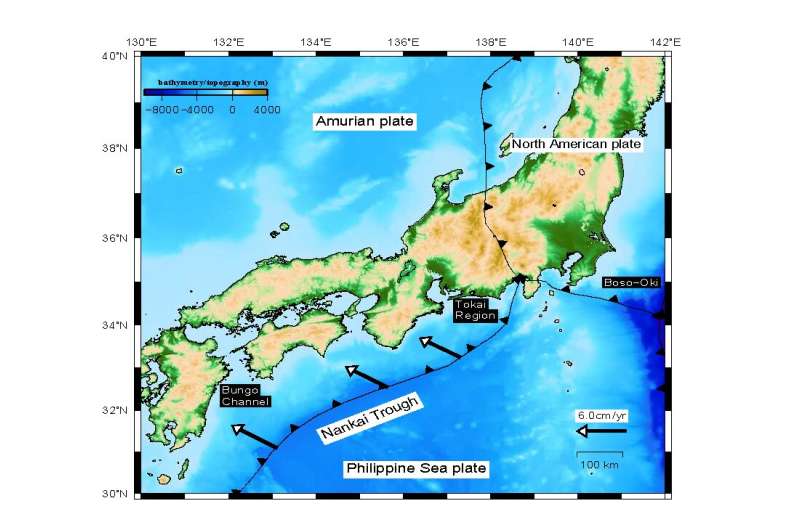This article has been reviewed according to Science X's editorial process and policies. Editors have highlighted the following attributes while ensuring the content's credibility:
fact-checked
peer-reviewed publication
trusted source
proofread
New insight into the relationship between slow slip events and the build-up and release of tectonic strain

The Japanese archipelago is actively undergoing seismic shifts due to interactions between the oceanic plate and the continental plate. At the plate boundaries located directly beneath areas of Japan (especially the Bungo Channel, Tokai and Boso-Oki regions), slow slip events (SSEs) occur, which involve gradual aseismic slipping taking place at a recurrence interval of several years.
However, it is still not clear exactly how tectonic strain is accumulated and released in association with SSEs in these regions. A thorough understanding of SSEs would improve our knowledge of how megathrust earthquakes occur, leading to better forecasts.
To shed some light on this, Kobe University's Kawabata Hiroki and Professor Yoshioka Shoichi (Research Center for Urban Safety and Security) used GNSS time series data to investigate the relationship between strain accumulation and release before and after the occurrence of SSEs in the Bungo Channel, Tokai and Boso-Oki regions.
The results for all regions investigated revealed that not all of the accumulated strain is released when an SSE occurs. In addition, this release only occurs at the plate interface directly underneath. In contrast to this, it is highly likely that strain build-up not only happens in the SSE area but also in the shallow part of the plate boundary; in other words, the zone where a future megathrust earthquake could potentially occur. This new understanding is expected to contribute towards better earthquake forecasts in the future.
These results were published in Scientific Reports.
Main points
- An SSE is a phenomenon believed to be related to the occurrence of powerful megathrust earthquakes. Consequently, SSEs have received a lot of attention in recent years.
- This research study analyzed past slow slip events that occurred in the following areas of Japan: the Bungo Channel, the Tokai Region and Boso-Oki.
- A fundamental phenomenon that causes earthquakes is the accumulation and subsequent release of tectonic strain. Comprehensive research (that encompasses slow slip events and strain accumulation/release) is therefore considered vital to illuminate the onset mechanism behind megathrust earthquakes (such as the highly devastating Nankai Trough megathrust earthquake, which is forecasted to occur in the near future).
SSEs background
SSEs occur at the interface of tectonic plates, located underground below areas including the Bungo Channel, the Tokai Region and Boso-Oki. SSEs involve gradual aseismic slipping on the plate interface at a recurrence interval of several years. Plates sliding against each other in this manner is caused by the release of strain that has accumulated at the plate boundary. This movement is one of the fundamental causes of earthquakes.
Many research studies have been conducted on SSEs up until now, however they tend to focus on one type. Studies have not examined different durations of SSEs across multiple regions from the perspective of strain accumulation and release. SSEs are linked to the occurrence of megathrust earthquakes. Therefore, it is vital to investigate SSE-related strain accumulation and release in order to illuminate the causal mechanism behind megathrust earthquakes.
This study analyzed past SSEs that have occurred in the Bungo Channel, Tokai and Boso-Oki regions of Japan.
GNSS time series data and models
The researchers used GNSS time series data provided by the Geospatial Information Authority of Japan to analyze the amount and spatial distribution of strain accumulation and release before and after SSE occurrence. They analyzed the following events: a Tokai Region long-term slow slip event (L-SSE) that occurred between 2000 and 2005, a short-term slow slip event (S-SSE) that occurred in Boso-Oki in 2007, and two Bungo Channel L-SSEs that occurred in 2009-2011 and 2018-2019, respectively.
These results confirmed that there was significant strain accumulation and release on the surface of the ground before and after SSE occurrence, respectively. Regardless of region, less than half of the strain accumulated beforehand was released when the SSE occurred.
In addition, the researchers also created models of plate interface adhesion and slippage for the Bungo Channel L-SSEs that could explain the analysis results well. The models revealed that the impact of SSEs is not limited to where they occur but is also connected to strain accumulation at the epicenter of megathrust earthquakes in shallower areas than the plate interface.
Slow slip events differ from people's typical image of an earthquake as they cannot be directly felt. However, they are intrinsically related to the occurrence of megathrust earthquakes, as indicated by this study. SSEs, especially those occurring in the Bungo Channel and Tokai regions, are considered important phenomena that could provide an early warning for earthquakes, including Tokai earthquakes and the devastating Nankai Trough megathrust earthquake (which is likely to occur in the near future).
It is hoped that investigating the relationship between the strain accumulation and release that accompanies SSEs in various regions throughout the Japanese archipelago will lead to new insight into the mechanism behind megathrust earthquakes as well as the state of interplate coupling.
More information: Hiroki Kawabata et al, Strain accumulation and release associated with the occurrence of SSEs in the subduction zones of the Japanese Islands, Scientific Reports (2023). DOI: 10.1038/s41598-023-28016-1
Journal information: Scientific Reports
Provided by Kobe University




















